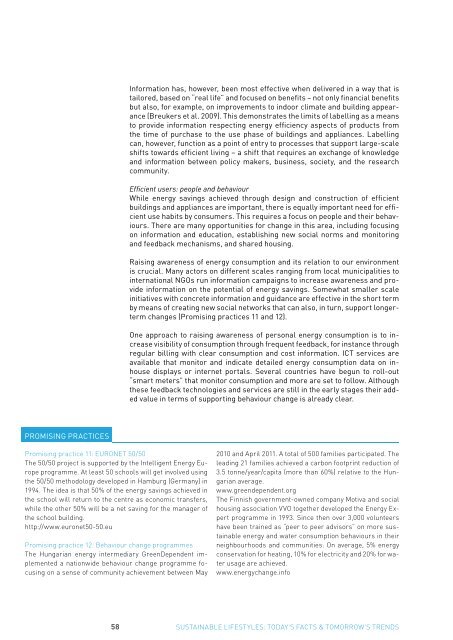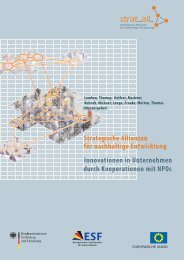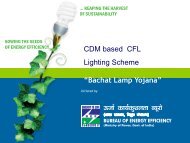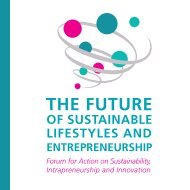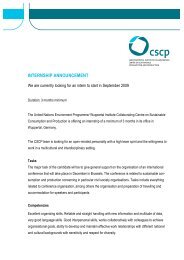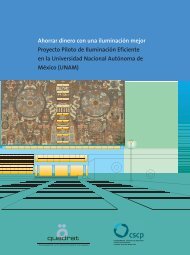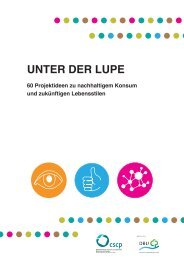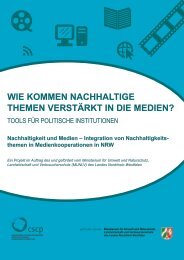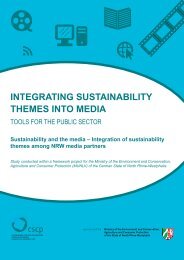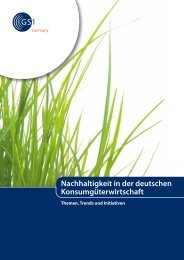today's facts & tomorrow's trends - SPREAD Sustainable Lifestyles ...
today's facts & tomorrow's trends - SPREAD Sustainable Lifestyles ...
today's facts & tomorrow's trends - SPREAD Sustainable Lifestyles ...
You also want an ePaper? Increase the reach of your titles
YUMPU automatically turns print PDFs into web optimized ePapers that Google loves.
Information has, however, been most effective when delivered in a way that is<br />
tailored, based on “real life” and focused on benefits – not only financial benefits<br />
but also, for example, on improvements to indoor climate and building appearance<br />
(Breukers et al. 2009). This demonstrates the limits of labelling as a means<br />
to provide information respecting energy efficiency aspects of products from<br />
the time of purchase to the use phase of buildings and appliances. Labelling<br />
can, however, function as a point of entry to processes that support large-scale<br />
shifts towards efficient living – a shift that requires an exchange of knowledge<br />
and information between policy makers, business, society, and the research<br />
community.<br />
Efficient users: people and behaviour<br />
While energy savings achieved through design and construction of efficient<br />
buildings and appliances are important, there is equally important need for efficient<br />
use habits by consumers. This requires a focus on people and their behaviours.<br />
There are many opportunities for change in this area, including focusing<br />
on information and education, establishing new social norms and monitoring<br />
and feedback mechanisms, and shared housing.<br />
Raising awareness of energy consumption and its relation to our environment<br />
is crucial. Many actors on different scales ranging from local municipalities to<br />
international NGOs run information campaigns to increase awareness and provide<br />
information on the potential of energy savings. Somewhat smaller scale<br />
initiatives with concrete information and guidance are effective in the short term<br />
by means of creating new social networks that can also, in turn, support longerterm<br />
changes (Promising practices 11 and 12).<br />
One approach to raising awareness of personal energy consumption is to increase<br />
visibility of consumption through frequent feedback, for instance through<br />
regular billing with clear consumption and cost information. ICT services are<br />
available that monitor and indicate detailed energy consumption data on inhouse<br />
displays or internet portals. Several countries have begun to roll-out<br />
“smart meters” that monitor consumption and more are set to follow. Although<br />
these feedback technologies and services are still in the early stages their added<br />
value in terms of supporting behaviour change is already clear.<br />
Promising practices<br />
Promising practice 11: EURONET 50/50<br />
The 50/50 project is supported by the Intelligent Energy Europe<br />
programme. At least 50 schools will get involved using<br />
the 50/50 methodology developed in Hamburg (Germany) in<br />
1994. The idea is that 50% of the energy savings achieved in<br />
the school will return to the centre as economic transfers,<br />
while the other 50% will be a net saving for the manager of<br />
the school building.<br />
http://www.euronet50-50.eu<br />
Promising practice 12: Behaviour change programmes<br />
The Hungarian energy intermediary GreenDependent implemented<br />
a nationwide behaviour change programme focusing<br />
on a sense of community achievement between May<br />
2010 and April 2011. A total of 500 families participated. The<br />
leading 21 families achieved a carbon footprint reduction of<br />
3.5 tonne/year/capita (more than 60%) relative to the Hungarian<br />
average.<br />
www.greendependent.org<br />
The Finnish government-owned company Motiva and social<br />
housing association VVO together developed the Energy Expert<br />
programme in 1993. Since then over 3,000 volunteers<br />
have been trained as “peer to peer advisors” on more sustainable<br />
energy and water consumption behaviours in their<br />
neighbourhoods and communities. On average, 5% energy<br />
conservation for heating, 10% for electricity and 20% for water<br />
usage are achieved.<br />
www.energychange.info<br />
58<br />
SUSTAINABLE LIFESTYLES: TODAY’S FACTS & TOMORROW’S TRENDS


